- home
- BAKERECIPES
BakeRecipes
Bringing real baking into your home with deliciously simple recipes.
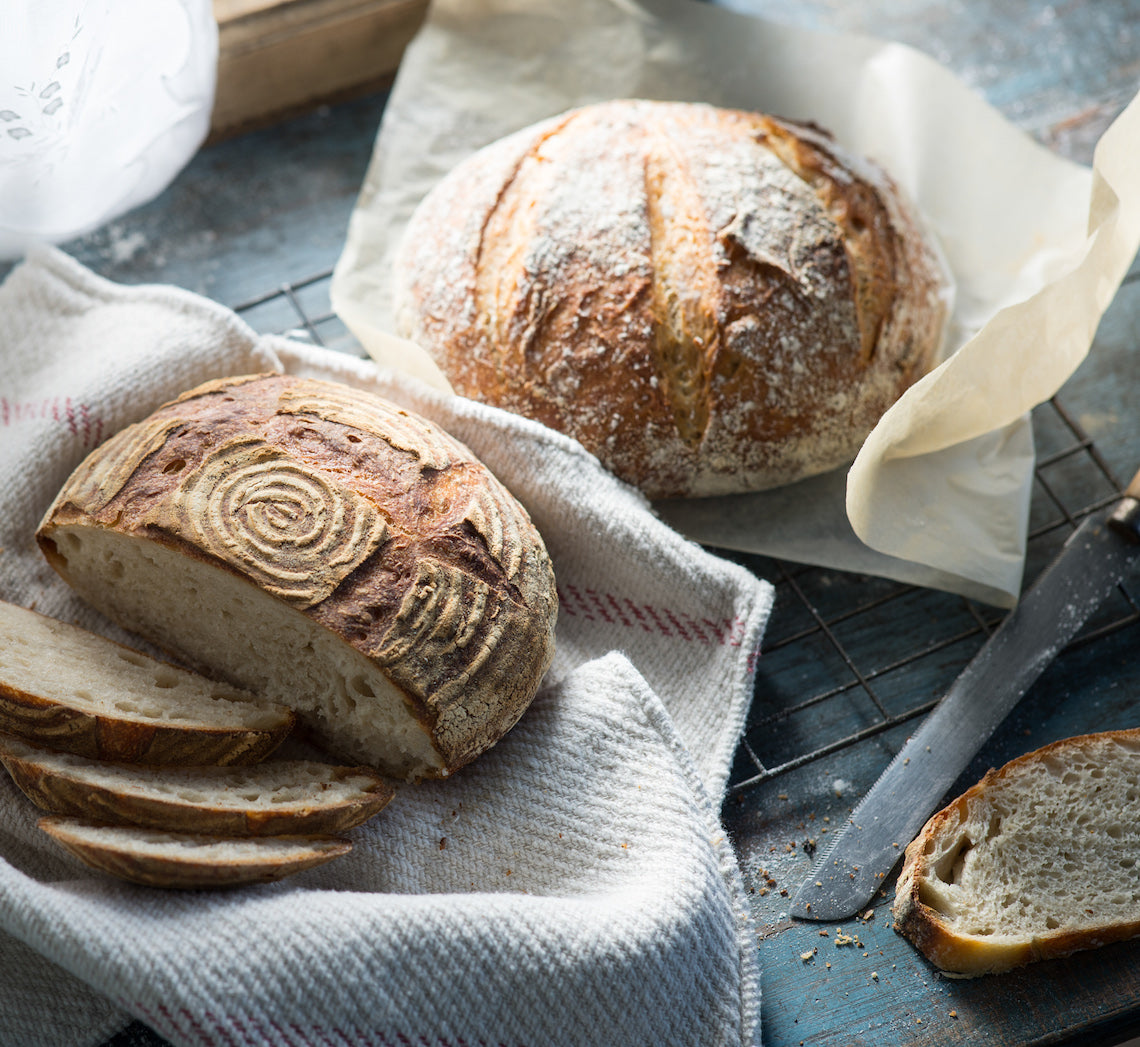
Prep 1hr (+12-14hrs / overnight + 30min standing, 8.5-10hrs proving and 1hr cooling time)Bake 45-50minMakes 2 standard loaves
This is a well-tested recipe to begin your sourdough baking. It's made with white flour but you can use spelt instead.
This recipe is one I have made many times with great results. Before you get started, read over my tips and tricks for making and baking sourdough bread.
It does take at least 24 hours from start to finish but time is what helps create a great loaf of sourdough. I have included some time variations throughout to allow the making of this sourdough fit more easily into your day. This dough is folded six times (not kneaded) with rests in between. Below is a timeline to help you map out your day of baking:
Feed your sourdough starter to get it active, 4–8 hours
↓ ↓
Make levain, stand 12 hours (overnight)
↓ ↓
Mix levain + dough, stand 1 hour
↓ ↓
1st folding, prove 30 minutes
↓ ↓
2nd folding, prove 30 minutes
↓ ↓
3rd folding, prove 30 minutes
↓ ↓
4th folding, prove 30 minutes
↓ ↓
5th folding, prove 30 minutes
↓ ↓
6th folding, prove 1 hour (or up to 4 hours)
↓ ↓
Cut into loaves, prove 1—2 hours
↓ ↓
Shape loaves, prove 2—3 hours
(OR prove 1 hour, then transfer to fridge for 12-14 hours)
↓ ↓
Bake at 240ºC for 20 minutes, then 220ºC for 20-25 minutes
↓ ↓
Cool (1 hour), slice, eat!
Ingredients
Strong bread or pizza flour (12-15% protein content), for dusting
Rice flour, for preparing proving baskets (optional)
Levain
50g active sourdough starter80g (80ml/⅓ cup) lukewarm water
75g (½ cup) strong bread or pizza flour (12-15% protein content)
Dough
500g (500ml/2 cups) lukewarm water700g (4⅔ cups) strong bread or pizza flour (12-15% protein content), plus extra for dusting
2½ teaspoons fine sea salt
Method
- To make the levain, combine the sourdough starter, water and flour (see image 2) in a medium bowl and mix until well combined. Cover with plastic wrap and stand in a warm, draught-free place (approx. 24.5- 28°C) overnight (12-14 hours). The levain should have expanded and be very bubbly and may even double (see image 3) when it is ready to use (see Baker’s Tips #1).
- To make the dough, transfer the levain to a large bowl. Add half the water and use a balloon whisk or spatula to break up the levain until almost smooth. Stir in the remaining water. Add the flour to the levain mixture, sprinkle over the salt, and stir with a wooden spoon until combined and a very shaggy dough forms (see image 4). Cover the bowl with plastic wrap and set aside in a warm, draught-free place (approx. 24.5-28°C) for 1 hour.
- Instead of kneading, you are going to stretch and fold the dough (see Baker’s Tip #2). Leave the dough in the bowl and use your fingertips to pick up the top side of the dough (furthest away from you), lift it up as you stretch it, and then fold it back on itself (see image 5). Turn the bowl a quarter turn and repeat this stretching and folding process three more times, turning the bowl after each fold. Cover with plastic wrap and set aside in a warm, draught-free place (approx. 24.5-28°C) for 30 minutes. Repeat this folding process five more times (which will be 6 foldings in total), resting the dough for 30 minutes between each time you fold (see Baker’s Tip #3). When you begin this process the dough will be unevenly textured and shaggy in appearance but will become less so as you continue to stretch, fold and rest/prove. Once all six folding, stretching and resting processes have been completed, the dough will be very smooth, spongy and elastic (see image 6).
- Once you have stretched and folded the dough a total of 6 times, cover and place in a warm draught-free place (approx. 24.5-28°C) for 1 hour or until well puffed (see Baker’s Tips #4).
- Gently turn the dough out of the bowl onto a well- floured surface, being careful not to deflate it. Use a sharp knife or a pastry scraper to cut the dough in half (see image 7). Use well-floured hands or a pastry scraper to shape each dough portion into a loose round. Cover each dough round with an upturned bowl (large enough so the dough has room to rise) (see image 8) and leave to rest for 1 1⁄2-2 hours or until well puffed.
- Dust 2 clean, loosely woven cloths or tea towels generously with flour and then use your fingers to rub the flour into the cloth (see images 9). Line two 19-22cm (top measurement) round dough proving baskets or colanders with the cloths. If using traditional proving baskets, you don’t need to line them with a cloth (particularly if you want the bread to take on the lovely pattern of the basket), just dust and rub the insides of the baskets generously with rice flour and/or bread flour.
- Dust the top of one of the dough portions with flour. Turn it over and then use a similar folding action in Step 3 to shape into a round loaf, pulling the edges of the dough into the centre so that the dough surface underneath is tight to help shape it, only folding 6 times to help retain as much air as possible (see images 10-11). Gently turn the loaf over again (so that the smooth surface is on top) and use the palms of your hands to shape and even the round, stretching the top surface of the dough towards its base (see image 12). Be firm yet gentle when shaping the dough – you want to form the dough so it holds its shape but not be too forceful that you lose the valuable air bubbles (your technique will improve with practise). Repeat with the remaining dough portion. Dust the top of the loaves with a little more flour and use the palm of your hand to gently spread it over the top and sides to coat. Carefully turn each loaf over and lift into a proving basket or colander, top side down (see Baker’s Tip #5). If using cloths, loosely fold the overhanging edges over the dough.
- Place each of the loaves in their baskets or colanders in sealed plastic bags (see Baker’s Tip #6). Set aside in a warm draught-free place for 2-3 hours to prove or until well risen (see Baker’s Tip #7) (see image 13).
- Preheat the oven to 240ºC (220ºC fan-forced) (read tips here). Line two heavy baking trays with non-stick baking paper (see Baker’s Tips #8).
- Very gently turn a loaf onto a lined tray so that you retain as much air as possible, leaving the second loaf in the proving basket (see Baker’s Tip #9). Use a bread lame or very sharp knife to score the surface of the loaf, about 1.5cm deep, in a pattern of your choice (see image 14). Dip your hand in water and flick it onto the top of the loaf to sprinkle three times. Place the loaf in the oven, thrown a small bowlful of ice cubes into the bottom of the oven and immediately close the door (see Baker’s Tip #10). Bake for 25 minutes.
- Reduce the oven temperature to 220°C (200°C fan-forced) and bake for another 20-25 minutes or until the crust is deeply coloured and the loaves sound hollow when tapped on the base. Transfer the loaves to a wire rack and set aside to cool completely before slicing.
Baking in a Covered Pot
If baking your dough in a covered pot preheat it with the oven. Turn the dough out of the proving basket onto a piece of non-stick baking paper large enough to line the base and sides of the pot. Sprinkle the dough with water as in Step 10. Carefully lift the bread dough into the heated pot and score the top as desired. Cover with the lid and bake in the preheated oven for 25 minutes. Remove the lid and bake, without reducing the oven temperature, for a further 25 minutes or until a deep golden and the loaf sounds hollow when tapped on the base.
If wanting to brown the base crust further, remove the bread from the pot and place directly on the oven rack, without the baking paper, and bake for a further 5-10 minutes.
Spelt sourdough variation
Replace the strong bread or pizza flour with wholemeal spelt flour. Note, because of the lower gluten content of spelt wholemeal flour the resulting bread will be heavier and less ‘holey’ than the basic sourdough loaf. However, it will have a wonderful pleasant earthy flavour.
Baker's Tips
#1. When the levain is ready to use, a small teaspoon of it dropped into a glass of water should rise to the surface. This indicates that the levain is active and strong enough to produce enough carbon dioxide for it to be light enough to float.
#2. Stretching and folding the dough, along with the multiple resting/proving times in this recipe, replaces the kneading process to strengthen the gluten network in the dough, and produces a bread with quite large, uneven
air pockets and a great texture. The dough will be quite sticky and rubbing your fingers with a little water before stretching the dough will help stop it from sticking to them.
#3. It is particularly easy to lose track of how many times you have folded your dough. To make sure you don’t lose track, use a permanent pen to put a mark on the plastic wrap covering your dough, or write on a sticky note attached to the bowl, each time you finish a folding. Always remember to reset your timer too.
#4. In Step 4, you may need to stand/prove the dough for up to 4 hours depending on the proving temperature.
#5. Before adding the dough to the proving baskets or colanders make sure the surface of the dough is well floured – if it isn’t, it is likely to stick and the dough can lose valuable volume when you go to remove it which can result in a densely textured bread.
#6. Recycled plastic shopping bags or large snaplock bags work well to seal the dough in the basket or colander for the last proving stage. Sealing them in the bags means that the surface of the dough won’t dry out during proving. It will also help retain some of the heat generated by the yeast fermenting, helping to create a warm environment for your dough to prove in.
#7. When ready to bake, the dough will have risen by at least 50% and when poked with a finger a small indent will be left which will spring back slightly.
In Step 8, you can prove the loaves for 1-2 hours, or until risen slightly, in a warm draught-free place and then place them in the fridge overnight for 12-14 hours, if you wish. Stand the dough at room temperature in the baskets for 2-4 hours before turning out and baking.
#8. You can also bake the bread in a covered pot. See 'Baking in a Covered Pot' above.
#9. If you don’t have a large oven, it’s a good idea to bake the loaves separately. Leave the second loaf in the proving basket in the fridge while the first one bakes.
#10. If not baking your bread in a covered pot you can create steamy heat either by adding a tray with 1cm of water in the bottom of the oven before preheating it (as mentioned in Step 9) or by quickly throwing a bowlful of ice cubes into the bottom of your oven after adding your loaf and then immediately shutting the door. This will help give your bread the best possible ‘oven spring’ or rise when baking as well as contributing to a thick, crunchy crust (read tips here under 'Baking your Bread' to discover why).
This recipe is part of Anneka's SBS Food Bakeproof: Sourdough online column. For more Bakeproof columns and recipes, click here.
Photography by Alan Benson.
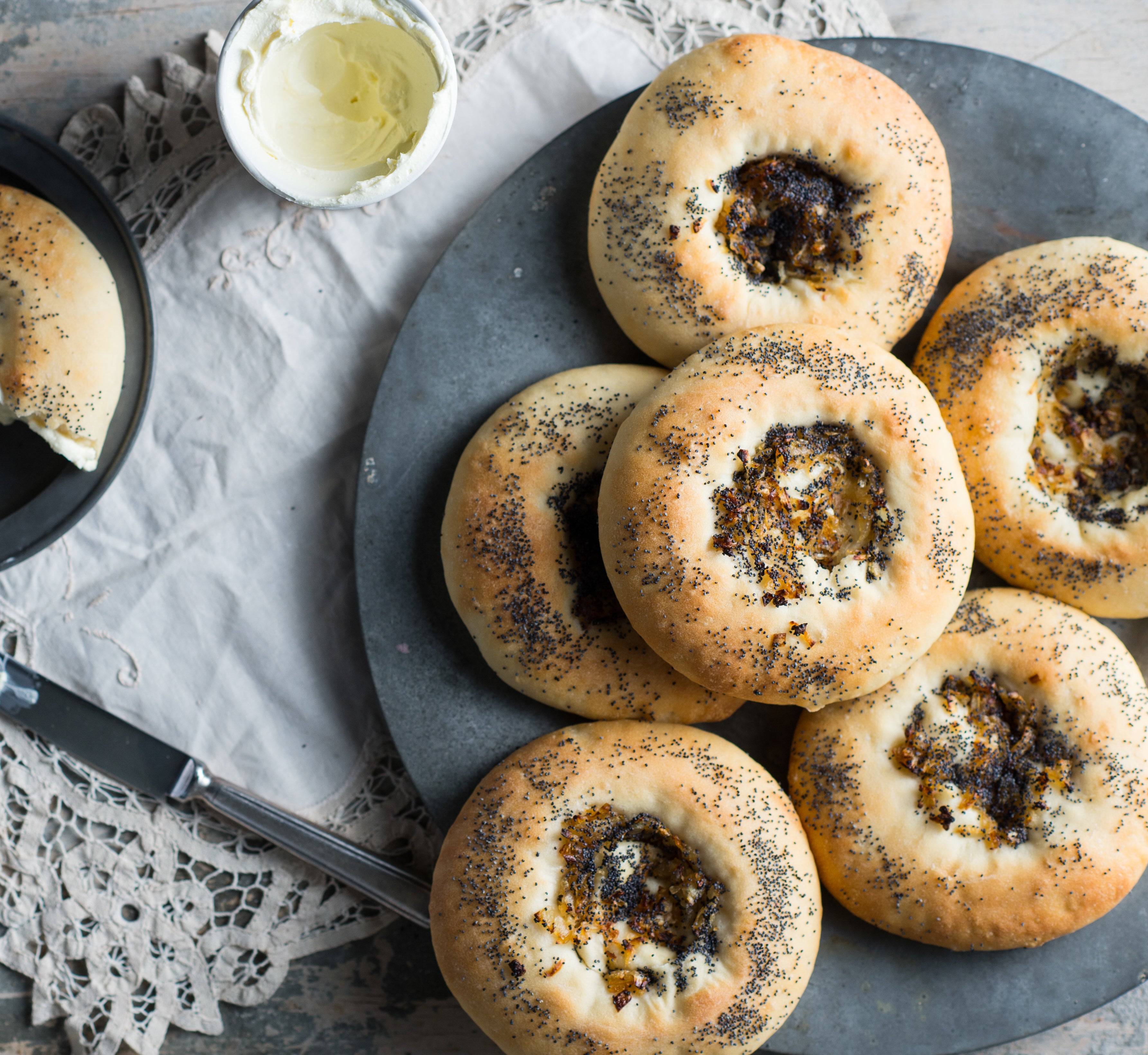
Prep 45min (+ 3hr 15min proving time)Bake 14minMakes about 8
They get their name from where they originated in the city of Białystok in north-eastern Poland. They are best eaten the day they are baked (even better warm) and spread with cream cheese or butter.
Ingredients
500ml (2 cups) lukewarm water
7g (1 sachet) instant dried yeast
2 teaspoons caster sugar
450g (3 cups) strong bread or pizza flour, plus extra to dust
340g (2¼ cups) plain flour
3 teaspoons fine salt
olive oil, to grease
Onion and poppy seed topping
1 tablespoon olive oil
1 medium brown onion, finely diced
½ teaspoon fine salt
2 tablespoons poppy seeds
Method
- Combine 60ml (¼ cup) of the lukewarm water with the yeast, sugar and 2 tablespoons of the bread flour in a small bowl and use a fork to whisk to combine. Set aside in a warm, draught-free place for 5 minutes or until the mixture is frothy.
- Combine the remaining bread flour, plain flour and salt in a large bowl. Combine the yeast mixture with the remaining water, add to the flour mixture and use a wooden spoon and then your hands to mix to a soft dough.
- Turn the dough onto a lightly floured surface and knead for 10 minutes or until it is smooth and elastic and springs back when you push your finger into it (see Baker’s Tips).
- Brush a large bowl with olive oil to grease. Add the dough turning it to coat lightly with olive oil. Cover with plastic wrap and place in a warm, draught-free place for 1½ hours or until doubled in size.
- When the dough has doubled in size knock it back by punching it in the centre with your fist. Recover with plastic wrap and place in a warm, draught-free place for 60 minutes or until doubled in size again.
- Line 2 large oven trays with non-stick baking paper. Turn the dough onto a lightly floured surface and knead briefly to bring the dough together. Divide the dough evenly into 8 equal portions and shape each into a ball. Use your hands to press, pinch and stretch a ball of dough into a disc about 12cm in diameter and 1cm thick. Repeat with the remaining balls of dough, placing them on the lined oven trays about 4cm apart. Cover with plastic wrap and set aside in a warm, draft-free place for 30 minutes or until risen by about half their volume.
- Preheat the oven to 210°C (190°C fan-forced). Meanwhile, to make the onion and poppy seed topping, place the olive oil, onion and salt in a small frying pan over medium heat and cook for 8-10 minutes until the onion is soft and starts to become golden. Remove from the heat.
- Use lightly floured fingertips to make an indent in the centre of the dough discs, leaving a 2cm border around the outside. Spoon the onion mixture into the indents, dividing evenly, and then sprinkle with the poppy seeds. Cover with a slightly damp tea towel and set aside in a warm draught-free place for 15 minutes or until slightly puffed.
- Bake in preheated oven for 12-14 minutes or until lightly golden and cooked through (see Baker’s Tips). Serve warm or at room temperature, spread with cream cheese or butter.
Baker's Tips
- You can also knead the bread dough in step 2 in an electric stand mixer fitted with a dough hook. Knead on lowest possible speed for 5-6 minutes or until smooth, elastic and the dough has come away from the sides of the bowl and the bowl is clean.
- Over-baking the bialy will cause them to become dry, so make sure you remove them from the oven as soon as they are baked through.
- These Bialy are best eaten the day they are made however they do freeze well. Seal in a freezer-proof plastic bag and freeze for up to 3 months. Thaw at room temperature and reheat by wrapping individually in foil and placing in an oven preheated to 160°C (140°C fan-forced) for 10 minutes or until heated through. Serve warm.
This recipe is part of Anneka's SBS Food Bakeproof: Jewish Baking online column. For more Bakeproof columns and recipes, click here.
Photography by Alan Benson.

Prep 30min (+1hr cooling and 30min standing time) Bake 40minMakes 10 serves
This dairy-free, flourless number is the Jewish Passover dessert of choice.
Ingredients
75g (⅔ cup) cocoa powder, sifted
165ml (⅔ cup) boiling water
200g pecans, toasted
1 teaspoon gluten-free baking powder
4 eggs, at room temperature
220g (1 cup) raw caster sugar
200ml light olive oil, plus extra to grease
1½ teaspoons natural vanilla essence or extract
Dairy-free ganache
185g dairy-free dark chocolate, chopped
60g dairy-free spread
Method
- Preheat oven to 170°C (150°C fan-forced). Grease a 22cm springform tin with extra oil and line the base with non-stick baking paper.
- Place the cocoa in a medium bowl and gradually stir in the boiling water until smooth. Set aside to cool.
- Process the pecans in a food processor until finely ground. Transfer to a medium bowl and stir through the baking powder until evenly combined.
- Use an electric mixer with a whisk attachment to whisk the eggs, sugar, oil and vanilla on high speed for about 5 minutes or until thick and pale. Add the cocoa mixture and whisk until just combined. Add the pecan mixture and stir until just combined.
- Pour the mixture into the prepared tin and bake in preheated oven for 40 minutes or until wet crumbs cling to a skewer inserted into the centre. Cool the cake in the tin sitting on a wire rack.
- To make the dairy-free ganache, combine the chocolate and dairy-free spread in a medium heatproof bowl over a saucepan of barley simmering water (make sure the waster doesn’t touch the bottom of the bowl). Stir occasionally until the chocolate melts and the mixture is smooth. Remove the bowl form the saucepan and set aside for 10 minutes, stirring occasionally, until the ganache thickens to a thick spreadable consistency.
- Remove the cake from the tin and place on serving plate. Spoon the ganache over the cake and use the back of a spoon to spread. Set the cake aside for 30 minutes or until the ganache sets. Serve in wedges.
Baker's Tips
- This cake will keep in an airtight container at room temperature for up to 1 week.
This recipe is part of Anneka's SBS Food Bakeproof: Jewish Baking online column. For more Bakeproof columns and recipes, click here.
Photography by Alan Benson.
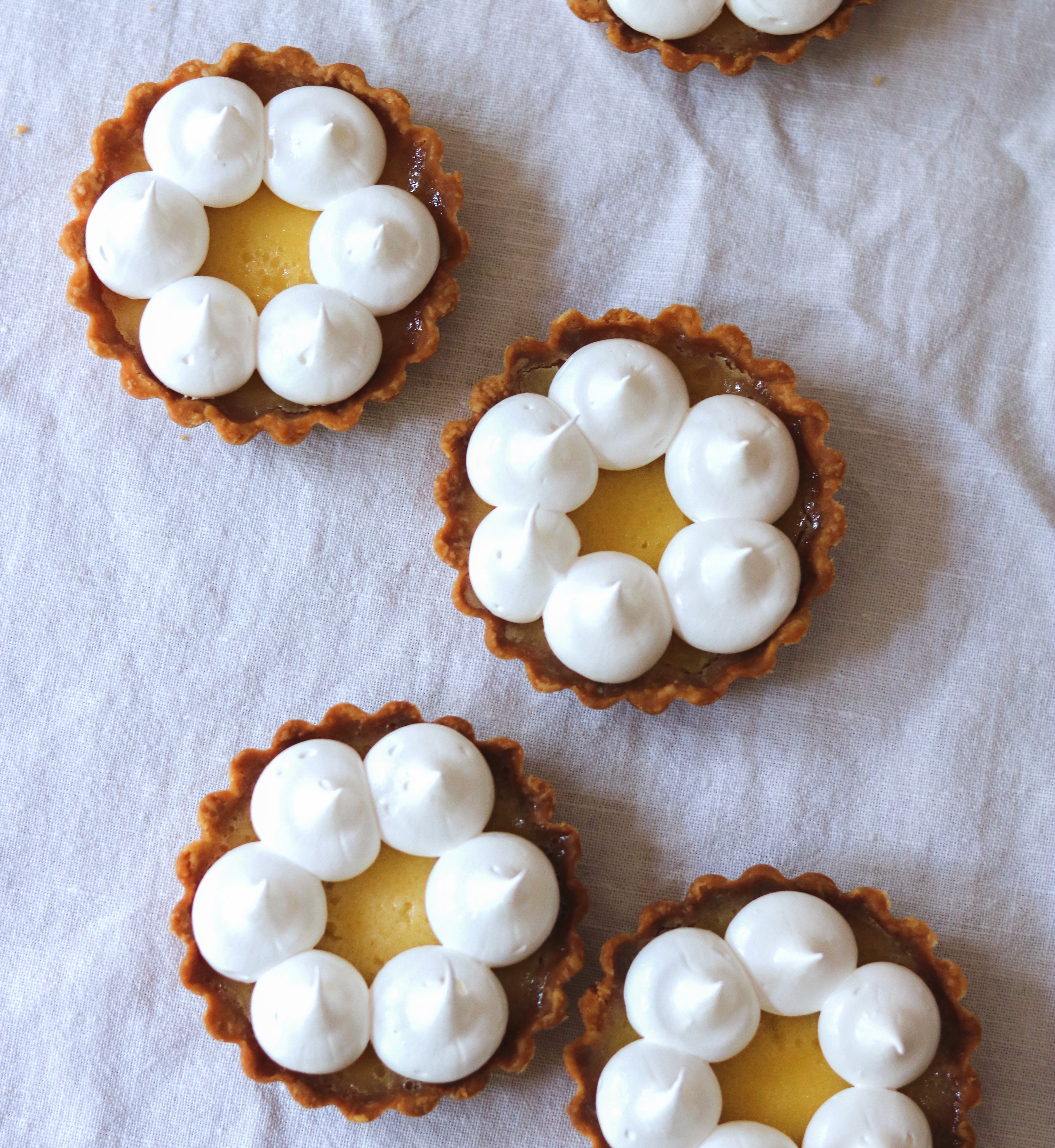
Prep 40min (+ pastry making time)Bake 35minMakes 10
Italian meringue makes an elegant topping for these classic tarts. You can caramelize the meringue lightly with a blow torch to add a delicate, slightly burnt caramel flavour to complement the sweetness of the meringue and sourness of the lemon filling if you wish.
Ingredients
1 quantity Sweet Shortcrust Pastry, rolled into a log about 15cm long before wrapping and chilling as directed
Icing sugar (optional), to sprinkle
Cream or ice cream, to serve
Filling
2 eggs110g (½ cup) caster sugar
125ml (½ cup) pouring (thin) cream
100ml strained fresh lemon juice
Italian Meringue
4 egg whites, at room temperature220g (1 cup) caster sugar
60ml (¼ cup) water
Method
-
Preheat the oven to 200°C (180°C fan-forced).
-
Remove the pastry from the fridge and cut into 10 even slices. Gently pat a pastry portion on a lightly floured benchtop with the palm of your hand to fatten slightly. Use a lightly floured rolling pin to roll out to a disc about 3mm thick. Line a 6.5cm (base measurement), 2cm deep, tart tin with removable base, with the pastry, pressing it into the side and corners with your thumb and/or fingertips. Roll the rolling pin over the top of the tart tin to trim any excess pastry. Repeat with the remaining pastry portions to make 10 tart cases in total.
-
Place the tart cases on an oven tray. Use a fork to prick the pastry base of each about 4 times. Line the pastry cases with squares of greaseproof paper or foil and fill with pastry weights, dried beans or raw rice, making sure they press into the corners and fill the cases. Bake in preheated oven for 10 minutes.
-
Remove the tart cases from the oven and use the paper or the foil to remove the weights from the cases. Return the cases to the oven and bake for a further 5-10 minutes or until the pastry is just cooked through and looks dry.
-
Meanwhile, to make the filling, use a fork to whisk the eggs, sugar, cream and lemon juice together until well combined. Strain the mixture into a jug. Pour the filling into the hot pastry cases while still in the oven (see Baker's Tips), dividing evenly. Reduce the oven temperature to 160°C (140°C fan-forced) and bake for a further 10 minutes or until the filling has just set in the centre but still wobbles slightly when shaken. Cool the tarts in the tins.
-
To make the Italian Meringue, put the egg whites in the bowl of a stand mixer fitted with a whisk attachment. Combine the sugar and water in a small saucepan and stir with a wooden spoon over low heat until the sugar dissolves. Increase the heat to medium and bring to the boil. Boil for about 10 minutes, occasionally brushing down the side of the pan with a pastry brush dipped in water to dissolve any sugar crystals, until the syrup reaches hard ball stage (120°C on a sugar thermometer).
-
Meanwhile, just before the syrup is ready, whisk the egg whites on high speed until firm peaks form. Remove the syrup from the heat and stand for a bout 1 minute or until the bubble subside. With the motor running on high speed, gradually add the sugar syrup in a thin steady stream until all the syrup has been incorporated. Continue to whisk on medium speed for another 10 minutes or until the meringue has cooled to room temperature.
-
Spoon the meringue mixture into a large piping bag fitted with a #13 (1.3cm) plain or #11 (1.1cm) star nozzle. Pipe small rounds of meringue over the surface of the tarts to cover. Use a blow torch to lightly caramelize the meringue if desired.
-
Dust with icing sugar, if desired and serve with cream or ice cream.
Baker's Tips
- Adding the filling to the pastry cases while still sitting in the oven will mean you can fill the tarts completely and minimise the chance of it spilling when transferring it to the oven.
- These tarts will keep in an airtight container in the fridge for up to 2 days (although the pastry will soften slightly on keeping). Bring to room temperature to serve.
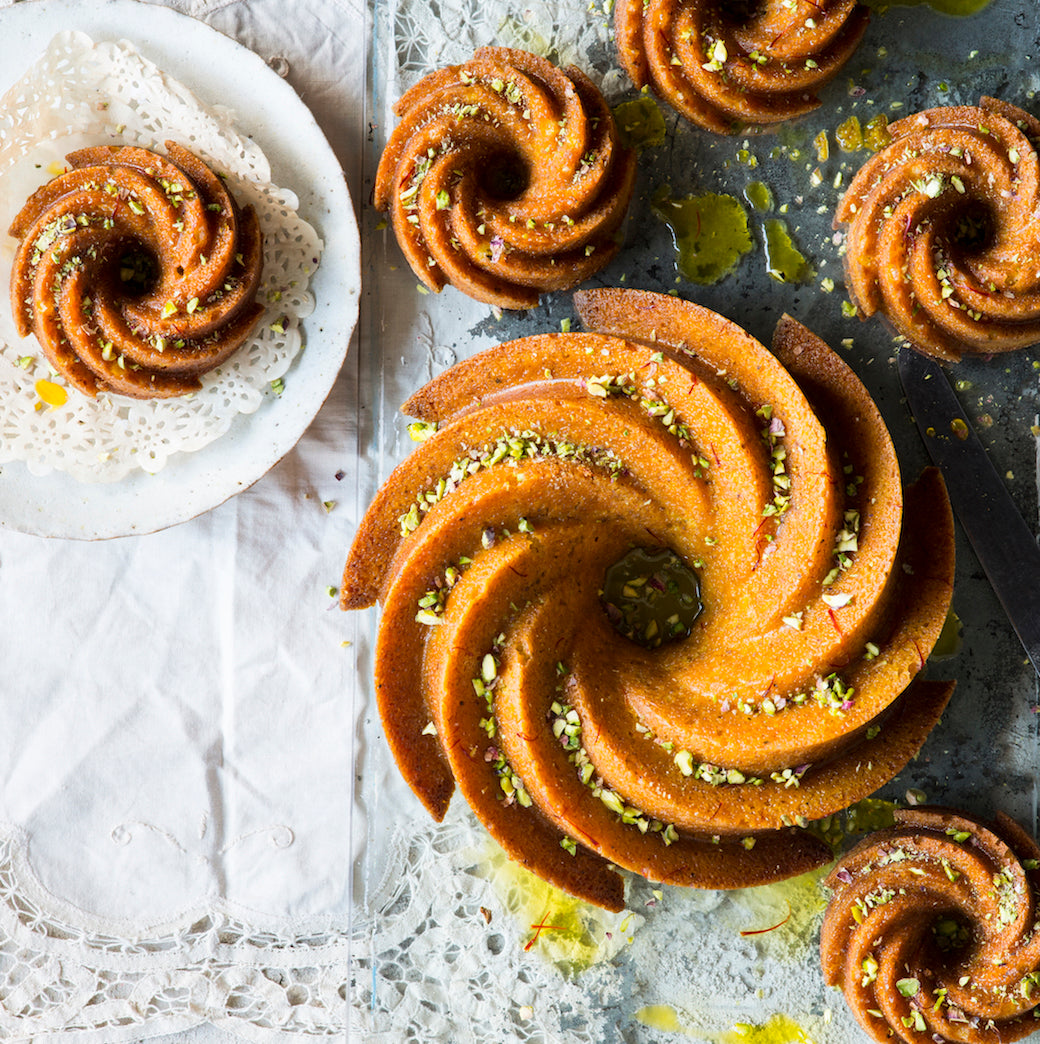
Prep 25min (+ 1hr cooling time)Bake 45minMakes 12 serves
This cake falls into that category of "less is more". The cake itself is a simple one-bowl mix whipped up in the food processor, but when baked in a decorative Bundt cake tin and infused with a flavoursome, and almost fluorescent, saffron syrup, it is one that will definitely impress.
Ingredients
15g (½oz) butter, melted
1 teaspoon plain flour
2 tablespoons unsalted pistachio kernels, toasted and chopped, to sprinkle
Orange and pistachio cake
100g (3½oz) unsalted pistachio kernels, toasted
1 orange (about 240g/8½oz), quartered, cored and seeds removed
220g (1 cup/7oz) caster sugar
125g (4½oz) salted butter, melted and cooled
2 eggs, at room temperature
185g (1¼ cups/6½oz) self-raising flour
Saffron syrup
1 large pinch saffron threads
125ml (½ cup/4fl oz) boiling water
125ml (½ cup/4fl oz) strained freshly squeezed orange juice
110g (½ cup/4oz) caster sugar
Method
- Preheat the oven to 170°C/340°F (150°C/300°F fan-forced). Combine the 15g/½oz melted butter with the 1 teaspoon plain flour and use a pastry brush to grease a 2 litre (8 cup/3.5pt) Bundt tin (see Baker's Tips).
- Place the pistachios in a food processor and process until very finely ground. Add the whole orange, sugar, butter and eggs to the food processor and process until the orange rind is finely chopped and the mixture is almost smooth. Add the self-raising flour and process briefly until just combined.
- Pour the mixture into the prepared tin. Tap the tin firmly on the benchtop 3 times to settle the mixture. Bake in preheated oven for 40-45 minutes or until a skewer inserted into the cake comes out clean. Stand the cake in the tin for 10 minutes.
- Meanwhile, place the saffron in a small dish and add about 1 tablespoon of the boiling water. Set aside to infuse. Combine the remaining boiling water, orange juice and sugar in a small saucepan and stir over low heat until the sugar dissolves. Add the saffron mixture, bring to a simmer over high heat. Reduce the heat to low and simmer for 5 minutes or until reduced slightly.
- Turn the cake onto a serving plate or cake stand with a lip. Gradually pour the hot saffron syrup over the hot cake, allowing it to soak in. Set aside and allow to cool (this will take about 1 hour). Serve sprinkled with the chopped pistachios.
Baker's Tips
- This cake will keep in an airtight container at room temperature for up to 3 days.
- I baked this cake in a Nordic Ware Heritage Bundt pan.
- You can also bake this cake as eight individual Bundts. Combine 30g (1oz) butter, melted, with 2 teaspoons plain flour and grease eight individual 250ml (1 cup/9fl oz) Bundt tins. Divide the mixture evenly among the tins and then tap them firmly on the benchtop 3 times to settle the mixture. Bake at 190°C/375°F (170°C/340°F) for 18-20 minutes or until a skewer inserted comes out clean. Stand in the tins for 5 minutes before turning onto a serving plate and pouring the syrup over. I used the Nordic Ware Heritage Bundtlette pans for these smaller Bundt cakes – each tray has 6 holes so you will have to bake the remaining two cakes separately.
This recipe is part of Anneka's SBS Food Bakeproof: Bundt Cakes online column. For more Bakeproof columns and recipes, click here.
Photography by Alan Benson.
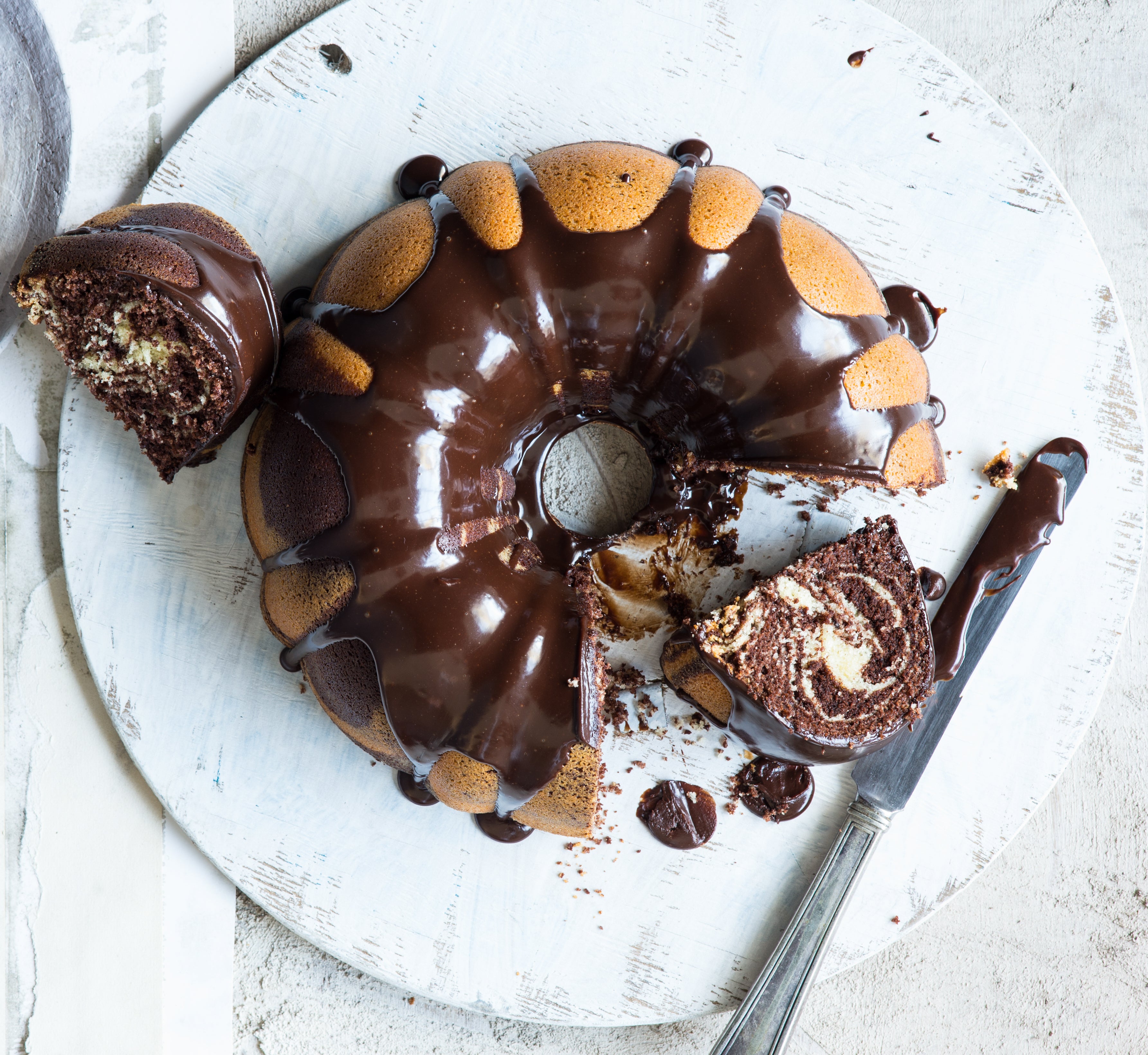
Prep 25min (+ 1hr cooling and 1hr standing time)Bake 55minMakes 12-14 serves
This is such a fun cake – the weight of alternating spoonfuls of mixture dropped on top of one another cause it to spread in the tin and create a wonderful ‘zebra’ stripped pattern that will be revealed when cut. It’s useful to remember that the smaller your spoonfuls of mixture are, the more delicate and intricate your design will be.
Ingredients
15g butter, melted
1 teaspoon plain flour
300g (2 cups) self-raising flour
70g plain flour
330g (1½ cups) caster sugar
250g salted butter, softened
4 eggs, at room temperature
185ml (¾ cup) water
2 teaspoons natural vanilla essence or extract
Cocoa mixture
55g (½ cup) cocoa powder, sifted
90ml boiling water
110g (½ cup) caster sugar
Chocolate fudge glaze
125g good-quality dark chocolate, chopped
110ml pouring (thin) cream
Method
- Preheat the oven to 170°C (150°C fan-forced). Combine the 15g melted butter with the 1 teaspoon plain flour and use a pastry brush to grease a 2 litre (8 cup) Bundt or fluted ring tin (see Baker's Tips).
- To make the cocoa mixture, place the cocoa in a medium bowl and gradually stir in the boiling water. Stir in the caster sugar and set aside.
- Put the flour, sugar, butter, eggs, water and vanilla in a large mixing bowl and use an electric mixer to beat on low speed until combined. Increase the speed to high and beat for 3-4 minutes or until paler in colour and silky smooth in texture. Transfer 2 cups (about 500g) of the cake mixture to a separate bowl. Add the cocoa mixture and use a spatula to mix until evenly combined.
- Drop a large spoonful of the vanilla mixture into the prepared cake tin. Drop a large spoonful of the cocoa mixture into the centre of the vanilla mixture. Continue dropping alternating spoonfuls of the mixtures into the tin directly on top of each other until all the mixture is used. The mixture will spread and even out as you add more, creating the ‘zebra’ pattern.
- Tap the tin firmly on the benchtop 3 times. Bake in preheated oven for 50-55 minutes or until a skewer inserted into the cake comes out clean. Stand the cake in the tin for 10 minutes before turning onto a wire rack to cool completely (this will take about 1 hour).
- To make the chocolate fudge glaze, place the chocolate in a heatproof bowl. Heat the cream in a small saucepan until almost simmering. Pour the hot cream over the chocolate and then set aside for 2 minutes. Stir until the chocolate melts and the mixture is smooth. Set aside at room temperature for 30 minutes, stirring occasionally, until thickened to a thick pouring consistency.
- Place the cake on the wire rack over a tray and pour the chocolate fudge glaze over. Set aside for 30 minutes or until the glaze sets.
Baker's Tips
- I used Baker’s Secret Fluted Tube Pan for this recipe but if you don't have this particular one, or a similar tin, you can use a greased and base-lined 24cm round cake tin instead.
- This cake will keep in an airtight container at room temperature for up to 2 days.
- The uniced cake also freezes well for up to 3 months. For the whole cake (or a portion of it), seal in an airtight container appropriate for its size before freezing. For individual pieces, wrap in plastic wrap and seal in an airtight container or freezer bag. Thaw at room temperature.
Photography by Alan Benson.
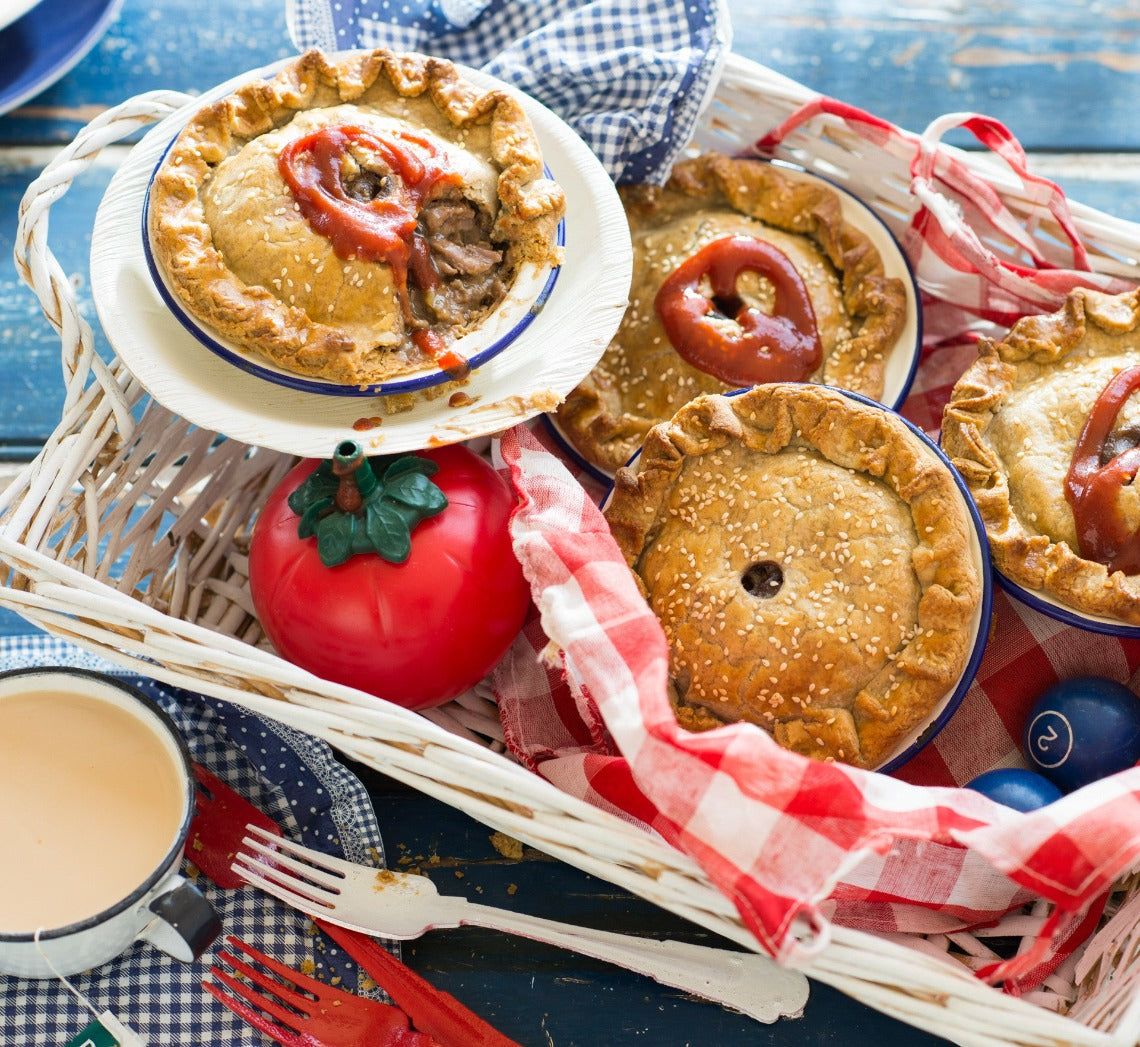
Prep 1hr (+2hr cooling and 5min standing time)Bake 2hr 30minMakes 6 serves
The addition of allspice, shiitake mushrooms, ginger and oyster sauce give these good old Aussie pies a subtle, but truly delicious, Chinese twist.
Ingredients
3 quantities shortcrust pastry (each with the addition of 1 teaspoon ground allspice added with the flour), each made separately and shaped into a disc before wrapping and chilling (see Baker's Tips)
1 egg, lightly whisked
sesame seeds, to sprinkle
Filling
1kg trimmed chuck steak, cut into 2cm chunks
35g (¼ cup) plain flour
60ml (¼ cup) peanut oil
2 small brown onions, chopped
200g shiitake mushrooms, sliced
2 garlic cloves, finely chopped
3 teaspoons finely grated ginger
250ml (1 cup) good-quality beef stock
500ml (2 cups) water
2 tablespoons oyster sauce, or to taste
Method
- Place the chuck steak in a large bowl, sprinkle with the flour and toss to coat.
- Heat 1 tablespoon of the oil in a large heavy-based saucepan over a high heat and cook half the steak chunks, stirring occasionally, for about 5 minutes or until sealed. Remove from the pan, scraping any cooked-on bits from the base, and set aside. Repeat with another tablespoon oil and the remaining steak.
- Clean the pan if necessary. Add the remaining 1 tablespoon oil, onion and shiitake mushrooms and cook over a medium-high heat, stirring occasionally, for 5 minutes or until the onion and mushrooms start to soften. Reduce the heat to medium, add the garlic and ginger and cook for a further 1 minute, stirring occasionally, or until aromatic. Return the steak to the pan with the stock, water and 1 tablespoon of the oyster sauce and bring to a simmer.
- Reduce heat to low and simmer, covered, for 30 minutes, stirring occasionally. Uncover and then simmer for a further 30 minutes to 1 hour, stirring frequently or until the meat is tender and the liquid has reduced and thickened to a thick sauce consistency. Stir in the remaining oyster sauce, taste and adjust seasoning by adding a little more oyster sauce if necessary. Transfer the mixture to a heatproof bowl, cover and place in the fridge, stirring occasionally, until cooled to room temperature (this will take about 2 hours).
- When ready to assemble the pies, preheat oven to 220°C (200°C fan-forced). Brush 6 x 10.5cm (base measurement) x 14cm (top measurement) metal or foil pie dishes. Unwrap the pastry discs and divide each into quarters. Shape a quarter into a disc and use a lightly floured rolling pin to roll the pastry on a lightly floured bench top into a round until about 3mm thick and about 15cm in diameter. Repeat with the remaining discs. Use an upturned pie dish to cut out pie lids from 6 of the rolled pastry rounds. Use the end of a 1cm piping nozzle or a small sharp knife to cut a small steam hole in the centre of each pie lid.
- Gently ease the the uncut pastry discs into the pie dishes and use your fingertips to press the pastry gently into the corners without stretching it — it will overhang the dishes slightly. Divide the steak mixture between the pastry cases to fill. Place a lid over the mixture to cover each pie, brush the edge of each lid with the whisked egg and then fold the excess pastry from the bases over the top of the lids, crimping with your fingertips or pressing with a fork together to seal. Brush the top of each pie lightly with some of the remaining egg wash and sprinkle with sesame seeds.
- Reduce the oven to 200°C (180°C fan-forced) and bake the pies in preheated oven for 45-50 minutes or until the pastry is cooked through and a deep golden. Stand the pies in the dishes for 5 minutes before turning out and serving.
Baker's Tips
- Don't be tempted to make the 3 quantities of pastry all at once. Making them separately makes the pastry easier to handle and will give you a better final result.
Photography by Alan Benson.Save
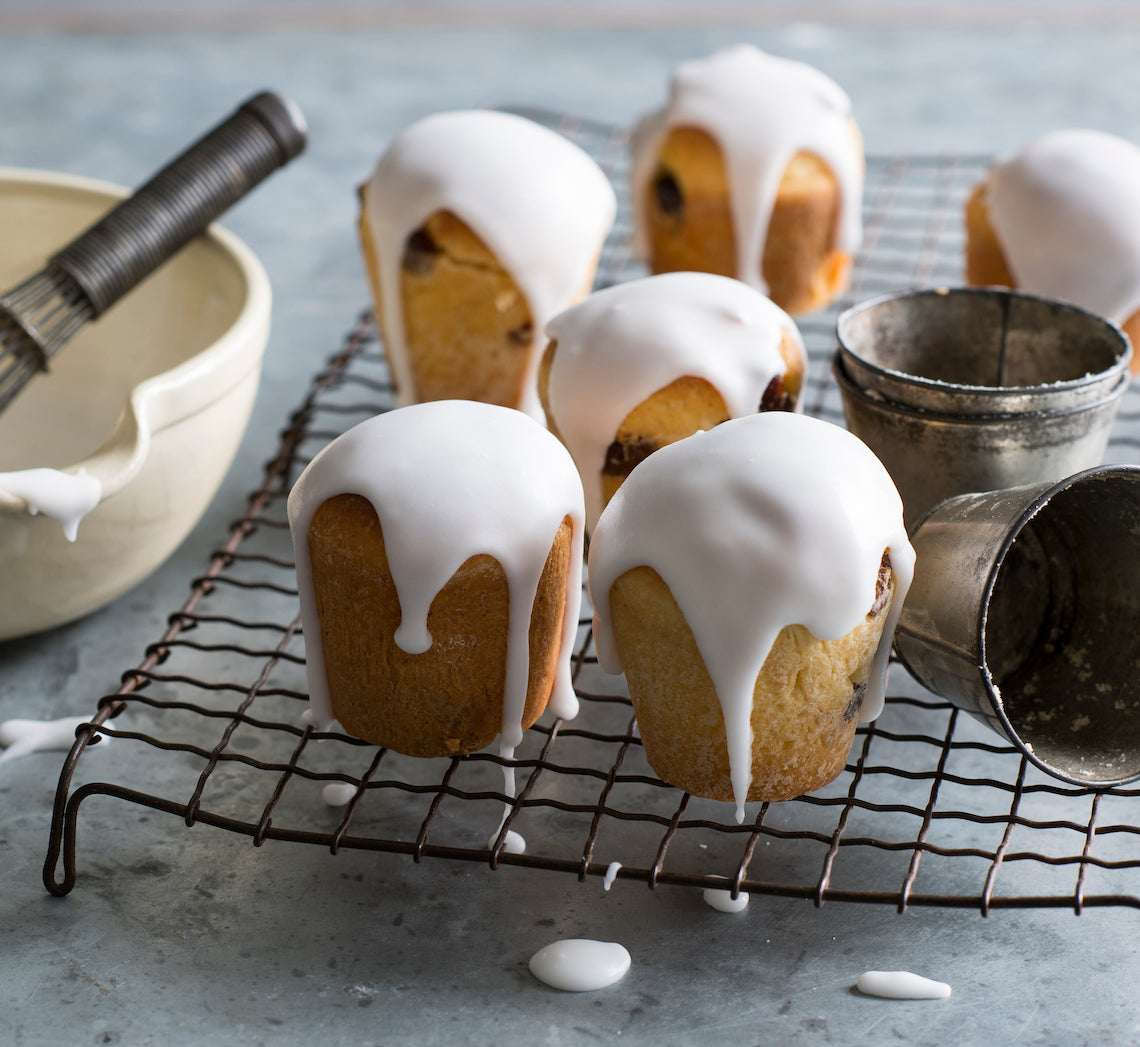
Prep 35min (+1hr 15min resting time)Bake 30minMakes 12
Many countries have their own version of this egg-rich, cake-like bread. This simple, slightly sweet, citrus-scented Ukrainian Easter one is typically baked in tall and cylindrical moulds just like Russian Kulich and Italian panettone.
Ingredients
5 egg yolks, at room temperature
1 whole egg, at room temperature
110g (½ cup) caster sugar
2 teaspoons natural vanilla essence or extract
½ teaspoon salt
185ml (¾ cup) lukewarm milk
10g (3 teaspoons) dried yeast
finely grated rind of 1 lemon
525g (3½ cups) plain flour, plus extra to dust
150g butter, cubed, at room temperature
170g (1 cup) seedless raisins
melted butter, to grease
Icing
370g (3 cups) pure icing sugar
3-4 tablespoons water
Method
- Put the egg yolks, egg, sugar, vanilla and salt in the bowl of a stand mixer and beat on high until pale and well combined. Add the milk, yeast and lemon rind and beat on low speed to combine. Gradually beat in 300g (2 cups) of the flour on low speed until combined. With the motor running gradually add the butter, a cube at a time, alternating with the remaining 225g (1½ cups) flour until a smooth, soft dough forms. Replace the beater with a dough hook and continue to knead on low speed for about 6 minutes or until very smooth and elastic. (Alternatively, turn onto a lightly floured bench and knead by hand for 10-15 minutes.) Knead in the raisins. Cover the dough in the bowl with plastic wrap and set aside in a warm draught-free place for 45 minutes or until doubled in size.
- Grease and lightly flour 12 x 125ml (½ cup) dariole moulds. Punch the centre of the dough down with your fist and turn onto a well-floured surface. Knead for 2-3 minutes or until smooth. Divide the dough into 12 equal portions, roll into balls and drop each into a prepared tin. Cover the moulds with a slightly damp tea towel and set aside in a warm draught-free place for 30 minutes or until the dough has risen to the top of the tins.
- Preheat the oven to 180°C.
- Bake the babkas in preheated oven for 28-30 minutes, covering the tops with foil if they start to brown too quickly, or until cooked when tested with a skewer and they sound hollow when tapped on the base. Stand in the moulds for 5 minutes before turning onto a wire rack to cool.
- To make the icing, put the icing sugar in a medium bowl and stir in the water to make a medium coating consistency. Spread over the tops of the babka, allowing it to drizzle down the sides. Set aside for the icing to set. Serve warm or at room temperature cut into slices.
Baker's Tips
- The babka dough can also be baked in two 9 x 19cm (base measurement) loaf tins. Grease and lightly flour as for the moulds. Divide the dough in half, roll each portion into a log about 15cm long and place in the prepared tins. Bake for 40 minutes or until cooked when tested with a skewer and they sound hollow when tapped on the base.
- This babka is best eaten the day it is made. To freeze, wrap well in plastic wrap and then seal in an airtight container or freezer bag and freeze for up to 3 months. Thaw at room temperature.
CLICK HERE for more Bakeproof recipes.
Photography by Alan Benson.
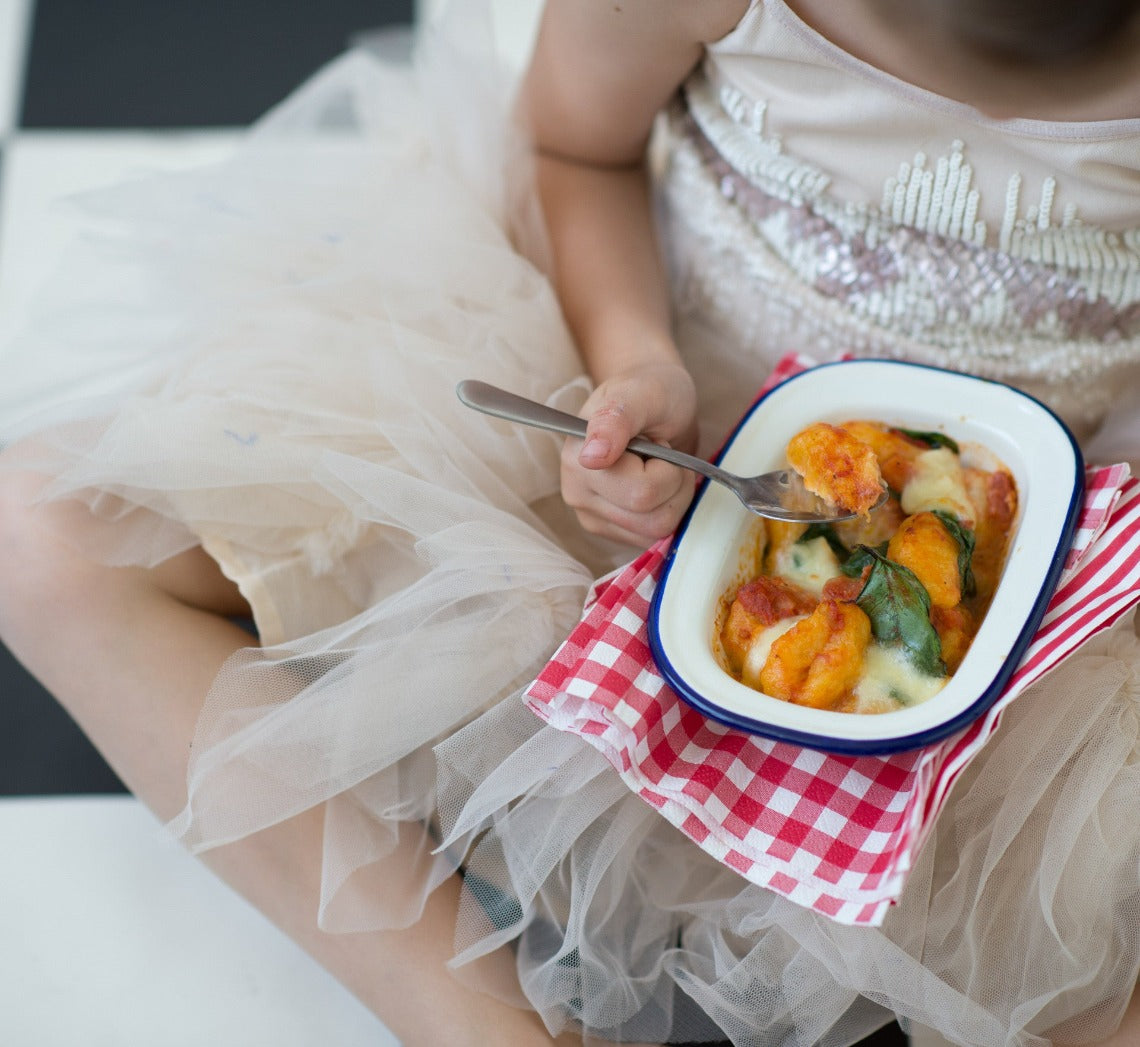
Prep 1hrBake 55minMakes 6 serves
Fun to make and scrumptious to eat, this homemade baked gnocchi combines pumpkin, tomatoes and spinach for a delicious, nutritious meal, made all the more fun by being served in individual dishes.
Ingredients
75g baby spinach
100g bocconcini, thinly sliced
Pumpkin gnocchi
350g unpeeled butternut pumpkin, deseeded and cut into 6 chunks
650g medium Desiree potatoes, unpeeled
salt and freshly ground black pepper, to taste
110g (½ cup) plain flour, plus extra to dust
Tomato sauce
100g bacon rashers, trimmed and chopped
1 garlic clove, crushed
1 x 400g can chopped tomatoes
1 teaspoon sugar
2 tablespoons pouring cream
salt and freshly ground black pepper, to taste
Method
- Preheat oven to 180°C (160°C fan-forced). Line a tray with a clean tea towel and dust lightly with flour.
- Place the pumpkin in an ovenproof dish, cover with foil and bake in preheated oven for 40 minutes or until tender when tested with a skewer. Set aside to cool slightly. Increase the oven temperature to 200°C (180°C fan-forced).
- Meanwhile, put the whole potatoes in a saucepan of water, cover with a lid and bring to the boil over medium heat. Boil for 30 minutes or until the potatoes are tender with tested with a skewer. Drain and set aside until cool enough to handle.
- Next, peel the warm potatoes, return the flesh to the dry saucepan and mash until smooth. Use a metal spoon to press a third of the potatoes through a coarse sieve or fine colander into a large bowl. Repeat with the remaining mashed potato in 2 more batches.
- Remove the pumpkin skin from the flesh and discard. Add the flesh to the potato and mash together. Season well with salt and pepper. Add the flour and use a wooden spoon and then your hands to mix to a firm but slightly sticky dough (adding a little more flour if necessary). Divide the dough into 4 equal portions and roll each out on a lightly floured bench top into a log about 2cm in diameter. Cut the logs into 2cm lengths and then roll each into a small ball. Gently roll each ball, one at a time, over the back of a lightly floured fork to form the gnocchi, placing on the tea towel-lined tray as they are finished.
- To make the tomato sauce, cook the bacon in a small saucepan over medium-high heat for 5 minutes, stirring occasionally, or until starting to colour. Add the garlic and cook for 1 minute or until aromatic. Add the tomatoes and sugar, bring to a simmer and simmer over medium-low heat for 10 minutes or until thickened slightly. Remove from the heat, stir through the cream and season with salt and pepper.
- Bring a large saucepan of salted water to the boil. Add a quarter of the gnocchi and boil for 2 minutes or until they just rise to the surface. Remove from the water immediately with a slotted spoon and place in a colander to drain well before transferring to a large bowl. Repeat with the remaining gnocchi in 3 more batches.
- Add the tomato sauce to the gnocchi with the spinach and gently stir through. Spoon the gnocchi and sauce into 6 x 250ml (1 cup) ovenproof dishes or ramekins, dividing evenly. Top with the bocconcini.
- Bake in preheated oven for 15 minutes or until bocconcini has melted and the sauce is bubbling. Remove from the oven and stand for 5 minutes before serving.
Baker's Tips
- You can also make this baked gnocchi by using 750g bought fresh gnocchi instead of making the pumpkin gnocchi.
- You can also bake this recipe in a 1.5 litre (6 cup) ovenproof dish. The baking time and temperature will be the same.
This recipe is from Anneka's SBS Food online column, Bakeproof: Kids in the Kitchen. CLICK HERE for more Bakeproof recipes.
Photography by Alan Benson.

Prep 25min (+1hr 10min cooling time)Bake 40-45minMakes 8-10 serves
One of Scandinavia’s most loved cakes, both Sweden and Denmark have their own version of this wonderful cake (and, like all great cakes, the origins are unclear). A rich, buttery, moist cake topped with a crisp caramel-almond Florentine-like topping it is simply too good to care too much about its origins!
Ingredients
Melted butter, to grease
50g (5¼oz) butter, at room temperature
110g (½ cup/4oz) caster sugar
1 teaspoon natural vanilla extract or essence
2 eggs, at room temperature
150g (1 cup/5¼oz) plain flour
1 teaspoon baking powder
80ml (⅓ cup/2½fl oz) milk
Vanilla ice-cream or thick cream, to serve
Caramel almond topping
70g (2½oz) butter, cubed
75g (⅓ cup/2½oz) caster sugar
70g (⅔ cup/2½oz) flaked almonds
2½ tablespoons (50ml/1¾fl oz) pure cream
1½ tablespoons plain flour
Method
- Preheat the oven to 170°C/340°F (150°C/300°F fan-forced). Grease a 22cm/8¾in springform tin with melted butter and line the base with non-stick baking paper.
- Use an electric mixer to beat the butter, sugar and vanilla in a large bowl until pale and creamy. Add the eggs one at a time, beating well after each addition. Sift together the flour and baking powder. Add half the flour mixture to the butter mixture and beat on lowest possible speed until just combined. Add the milk and beat on lowest possible speed until just combined. Add the remaining flour mixture and beat on lowest possible speed until just combined.
- Spoon the cake mixture into the prepared tin and smooth with the back of a spoon. Place the tin on a baking tray and bake in preheated oven for 30 minutes or until almost cooked.
- Meanwhile, when the cake has been in the oven for about 20 minutes, make the topping. Combine the butter, sugar, almonds, cream and flour in a medium saucepan. Use a wooden spoon to stir over medium heat until well combined and the sugar has dissolved. Bring to a simmer and cook for 2–3 minutes or until thickened slightly.
- Remove the cake from the oven and increase the temperature to 200°C/400°F (180°C/350°F fan-forced). Quickly pour the caramel almond topping evenly over the top of the cake and then use the back of a metal spoon to spread evenly to cover the top. Return the cake immediately to the oven and bake for a further 10–15 minutes or until the cake is cooked through and the topping is golden brown.
- Remove the cake from the oven and place on a wire rack to cool for 10 minutes. Run a spatula around the outside of the cake to release the topping from the pan. Carefully remove the sides of the pan and set the cake aside for 1 hour or until cooled completely.
- Serve in wedges with ice-cream or cream.
Baker's Tip
- This cake will keep in an airtight container for up to 3 days.
This recipe is from Anneka's SBS Food online column, Bakeproof: Scandi Baking. CLICK HERE for more Bakeproof recipes.
Photography by Alan Benson.
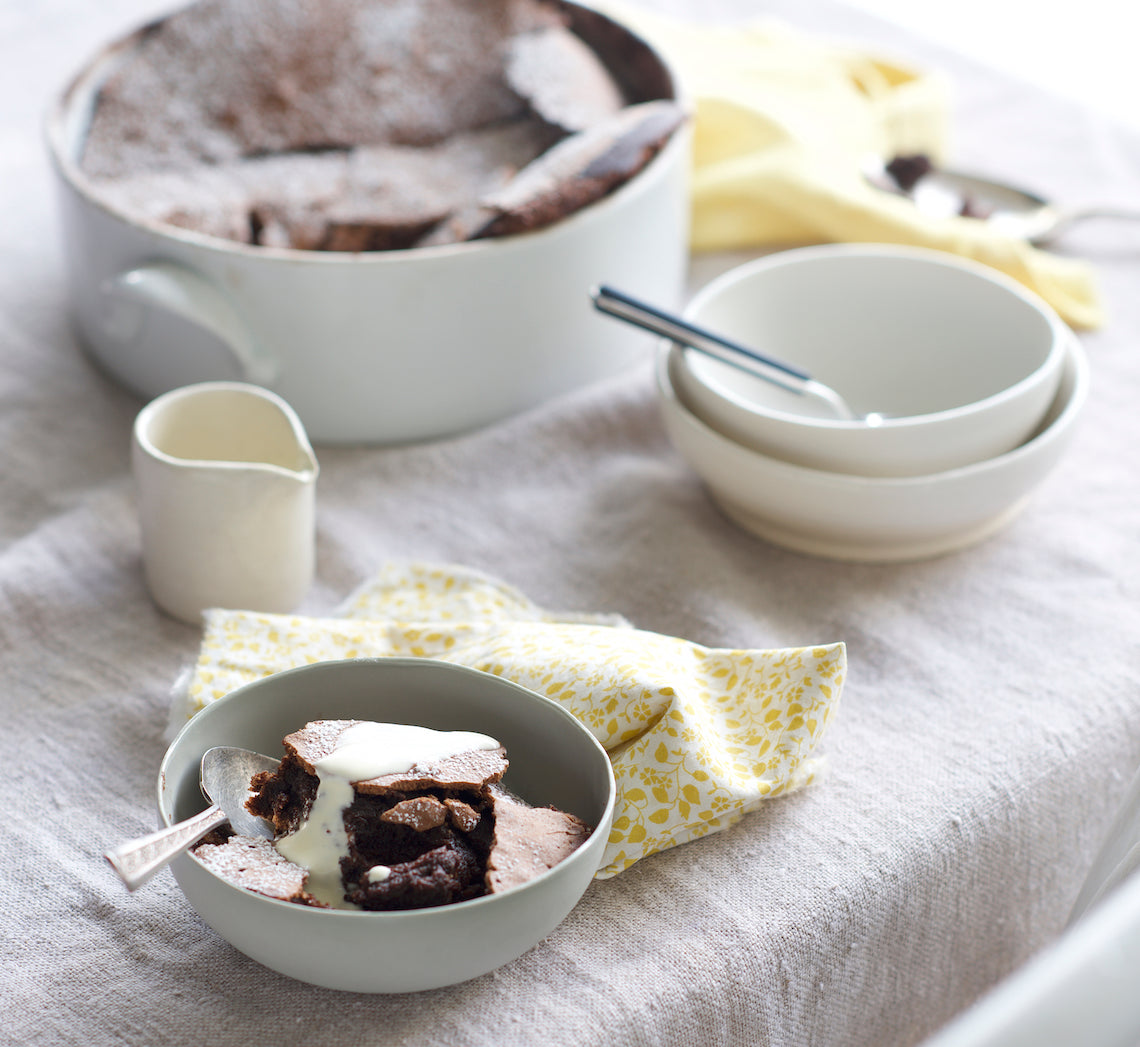
Prep 20min (+ 5min standing time)55-60minMakes 8 serves
I have been baking this gluten-free pudding for years. Not only is it completely heavenly, it is also very clever and can be baked as a cake when you want.
Ingredients
Melted butter, to grease
Cocoa powder, sifted, to dust
200g (1⅓ cups/7oz) chopped good-quality gluten-free dark chocolate (70 percent cocoa is good)
125g (4½oz) unsalted butter, cubed
2 tablespoons marsala wine or freshly brewed strong coffee
165g (¾ cup/5¾oz) caster sugar
5 eggs, at room temperature, separated
Gluten-free icing (confectioners’) sugar, to dust
Cream or gluten-free vanilla ice cream, to serve
Method
- Preheat the oven to 170°C/340°F (150°C/300°F fan-forced). Brush a 2 litre (8 cup/3½pt) capacity ovenproof dish (about 20cm/8in diameter) with melted butter to grease. Lightly dust with cocoa powder, tapping out any excess.
- Place the chocolate and butter in a medium heatproof bowl over a saucepan of simmering water, making sure the base of the bowl doesn't touch the water, and stir until melted and smooth. Transfer the mixture to a large bowl and stir in the marsala, 110g (½ cup/4oz) of the caster sugar and the egg yolks.
- Use an electric mixer with a whisk attachment to whisk the egg whites in a clean, dry large bowl on medium speed until soft peaks form. Add the remaining 55g (¼ cup/2oz) caster sugar and whisk until thick and glossy. Add one-third of the egg white mixture to the chocolate mixture and use a large metal spoon or spatula to fold together. Fold through the remaining egg white mixture until just combined.
- Pour the mixture into the prepared dish. Bake in the preheated oven for 55–60 minutes, or until crumbs cling to a skewer inserted in the centre.
- Remove the pudding from the oven and set aside for 5 minutes. Dust with icing sugar and serve in scoops with cream or ice cream.
Variation
Chocolate Soufflé Cake: Bake the mixture in a 22cm/8¾in (base measurement) springform cake tin that has been base-lined with baking paper, and then greased and dusted with cocoa powder. Bake at the same temperature for 55–60 minutes. Leave the cake to cool in the tin. Cut into wedges to serve.
Baker's Tips
- This pudding is also delicious served at room temperature. Leave to cool in the dish before serving.
- Any leftover pudding will keep covered in the fridge for up to 3 days. Leave to stand at room temperature for at least 30 minutes before serving.
Recipe and image from BakeClass by Anneka Manning (Murdoch Books).
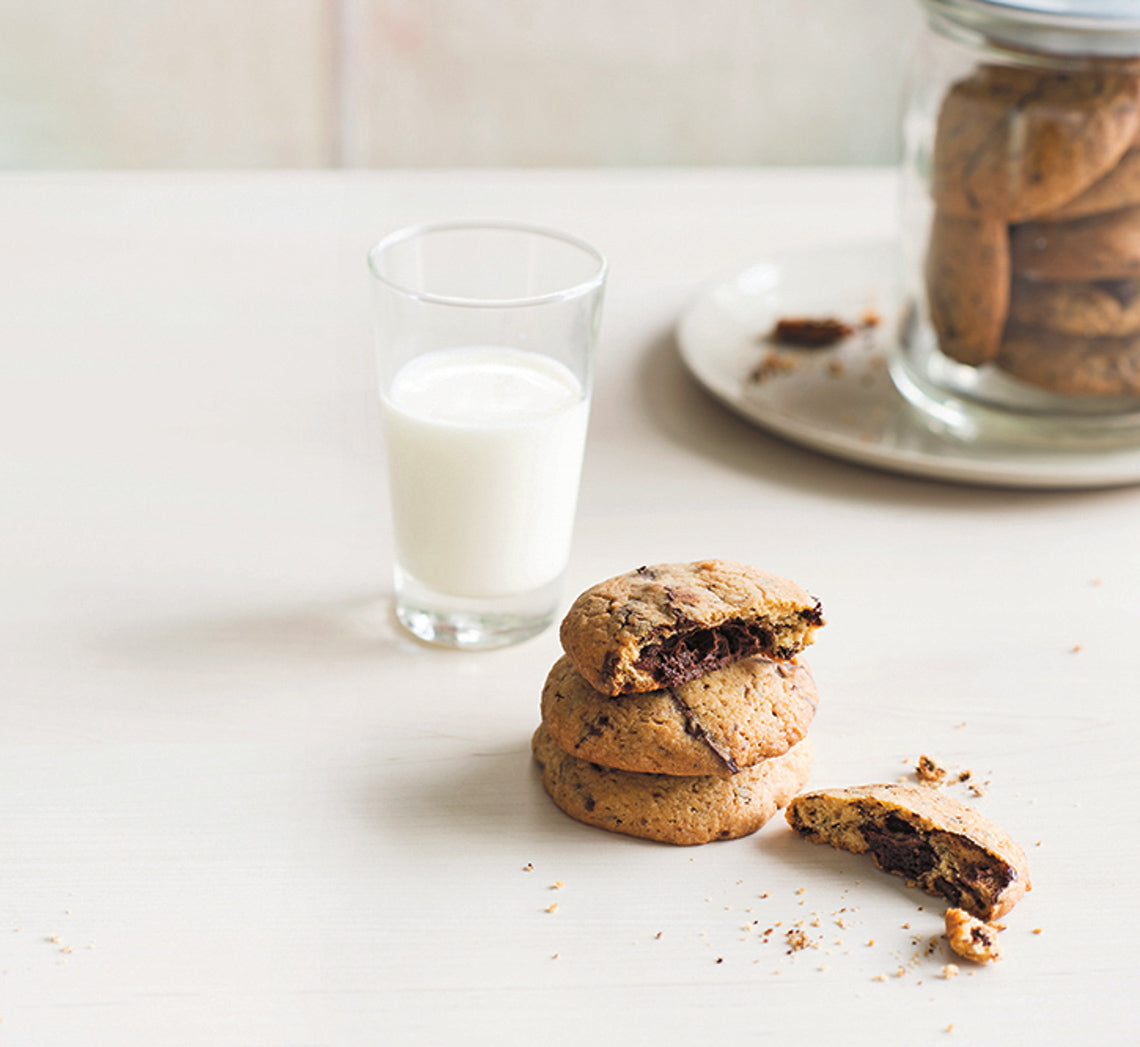
Prep 15min (+ 30min cooling time)Bake 20minMakes about 30
These good old-fashioned cookies are simple to make and even easier to devour! Either dark or milk chocolate (or a combination of the two) will work well – just take your pick. Eat them with a glass of cold milk.
Ingredients
125g butter, at room temperature, cubed
220g (1 cup, firmly packed) brown sugar
1 teaspoon natural vanilla extract or essence
2 eggs, at room temperature
300g (2 cups) plain (all-purpose) flour
1 teaspoon baking powder
200g good-quality dark or milk chocolate, chopped, or chocolate chips
Method
- Preheat the oven to 180°C or (160°C fan-forced). Line two large baking trays with baking paper.
- Use an electric mixer to beat the butter, sugar and vanilla until pale and creamy. Add the eggs one at a time, beating well after each addition. Sift together the flour and baking powder, add to the butter mixture and use a wooden spoon or spatula to mix until well combined. Mix in the chocolate.
- Roll tablespoonfuls of the mixture into balls and place on the oven trays, leaving about 5cm between each for spreading. Flatten each ball to about 5 cm in diameter.
- Bake in the preheated oven for 20 minutes, swapping the trays around halfway through baking, or until light golden and cooked through. Leave the cookies on the trays until cool (about 30 minutes).
Baker's Tips
- These cookies will keep in an airtight container at room temperature for up to 1 week.






